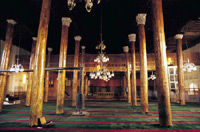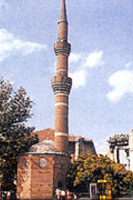Ankara
 Hacı Bayram Mosque and Mausoleum (Center): Mosque, which was constructed between 1425 and 1427, had been repaired for the third times. It has rectangular shape and its walls are fully made up of sun - dried bricks. Hacı Bayram Mausoleum, which is adjacent to mosque, was constructed with a square plan and half block stones after 1429. Embroidered wooden door of the mausoleum, which has a great importance in connection with art, is on exhibit in Ethnography Museum.
Hacı Bayram Mosque and Mausoleum (Center): Mosque, which was constructed between 1425 and 1427, had been repaired for the third times. It has rectangular shape and its walls are fully made up of sun - dried bricks. Hacı Bayram Mausoleum, which is adjacent to mosque, was constructed with a square plan and half block stones after 1429. Embroidered wooden door of the mausoleum, which has a great importance in connection with art, is on exhibit in Ethnography Museum.
Karacabey Mosque (İmaret Mosque, Center): It is constructed by Karacabey, who was one of the Ottoman Governors, according to the 1484 dated inscription. Invert "T" planned mosque’s final congregation places and side residences are preserving their authentic conditions today.
Minaret pedestal and minaret composing five edged salient parts are the most interesting part of the mosque with both its architectural structure and tiles on it. Wooden balcony is one of the most beautiful samples of the art of wooden engraving and carving among Ankara mosques.
Arslanhane Mosque (Ahi Şerafeddin Mosque, Center): The mosque, which has wooden columns and belongs to Ahiler period founded in Ankara during the last period of Seljuks, was constructed in 1290. Wooden columned mosques are 12 in Türkiye.

Augustus Temple (Center): Constructed during the 2nd century B. C., the temple is adjacent to Hacı Bayram Mosque. It was constructed by Galatlians in the name of Roman Emperor, Augustus. Monumental door of the temple and adornments on the side joists of the door draw attention. Political will of August has been written on the wall. This will is very important in the field of history.
Samanpazarı Synagogue (Center): Jewish Community living in Ankara worship in this synagogue. The synagogue is opened only for wedding ceremonies, funerals and special occasions.